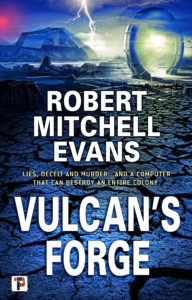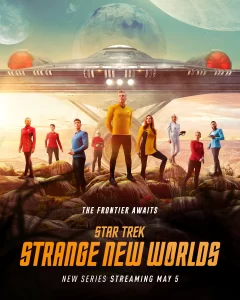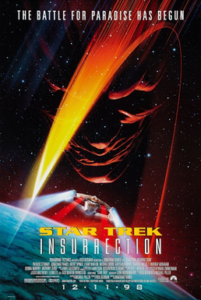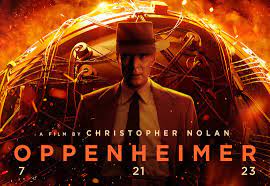.
As I write this, we are one episode away from the conclusion of Season 2 of Star Tre: Strange New Worlds. This season has brought more episodes that swung at new things and new styles than season one, a crossover episode with an animated Trek Series, and the franchise’s first foray into musical territory, while also exploring the deep dark of some of their characters.
The series remains straddling the two worlds of television, being both episodic with each episode pretty much a self-contained story but also with one foot in the saga format as events
from previous episodes reverberate both in plot and emotion for the characters.
The series is Canon breaking. The events and experiences of the characters cannot be reconciled with the depictions first aired more than 50 years ago. I am fine with that. The nature of televised story telling has changed dramatically over the last half century and what was acceptable writing and plotting in the middle of the 1960s would never fly for today’s audiences. I would rather the series creatives break Canon and continuity in the furtherance of good character development and story revelations that commit to slavish devotion to a Canon that wasn’t adhered to even during the original broadcasts. There are of course limits. A story that requires that James Kirk joined Starfleet because he was on the run as a serial killer would be a Canon breaking event far too great to accept but having original series characters meeting people that in the first broadcasts that they had no knowledge of. No big deal if the final effect is to tell a good story.
The entire cast continues to deliver stellar performances. (Pun intended, fully and without regret.) The storylines give most of them more to do than any series airing in the 60s would have dared. This season’s treatment of Jim Kirk has felt more in keeping with the original character than his guest appearance in season one. It is quite pleasant to see some of the more supporting characters from the original series getting a deeper backstory and more emotional exploration than they received originally. Spock’s stories seem to create the greatest conflict with ‘Canon,’ but I remind you that even the original series couldn’t make-up its mind on what exactly was the truth. In the episode Where No Man Has Gone Before he refers to an ‘ancestor’ that one married an Earth woman and later this is simply ignored to make his mother human. Having Spock explore and experiment with allowing his human side to be expressed more freely may be a Canon violation, but I find it fascinating.
The characters I am most interested in and have the greatest emotional attachment to are Dr M’Benga, La’an Noonian Singh, and most of all Christine Chapel.
La’an, torn between her nature, button-downed and controlled, and her desire to be more open, expressed in her solo in the musical episode but contained within Christina Chong’s performance well before that is emotionally powerful.
M’Benga and Chapel’s traumatic war wounds are touching and heart rending giving each of them far deep characterizations that the original series ever allowed. While the war itself was explored in the series Star Trek: Discovery, which didn’t quite work for me, I am thoroughly enjoying the exploration of war’s lasting effect on the people forced to endure it. Like Frodo they carry wounds that will never fully heal.
One more episode to go but since this is a not a season long story but a series of interconnected ones, I do not feel that the finale is as critical to the whole season as it would be for another series. So, I can render a judgement without episode 10 and I am enjoying the series even more than I had during season one. In my opinion the best Trek since the original.
A gentle reminder that I have my own SF novel available from any bookseller. Vulcan’s Forge is about the final human colony, one that attempt to live by the social standard of 1950s America  and the sole surviving outpost following Earth’s destruction. Jason Kessler doesn’t fit into the repressive 50s social constraints, and he desire for a more libertine lifestyle leads him into conspiracies and crime.
and the sole surviving outpost following Earth’s destruction. Jason Kessler doesn’t fit into the repressive 50s social constraints, and he desire for a more libertine lifestyle leads him into conspiracies and crime.




 .
.